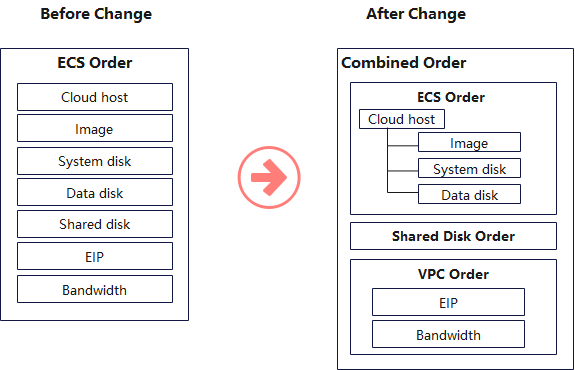What's New in Orders and Bills?
Huawei Cloud allows Elastic Cloud Server (ECS) to be traded and billed as a combined service, to improve your purchase, use and reconciliation experience.
Order for a Combined Service
All resources in a combined service are subscribed from, enabled, renewed, changed, unsubscribed from, frozen, unfrozen, deleted, and billed together. Any of them cannot be managed separately.
Example:
You placed a yearly/monthly subscription order for an ECS with the system disk, image, data disk, shared disk, EIP, and bandwidth resources added.

Before the combined service is introduced, only one order is generated, on which the ECS and all resources you added are listed.
After the combined service is introduced, a combined order is generated, including the following 3 orders:
- Order 1: ECS instance (including the ECS, image, system disk, and data disk resources). The instance is considered as a combined service, in which the ECS is the parent resource and the others are the child resources.
- Order 2: EVS disk instance (shared disk resources).
- Order 3: VPC instance (including the EIP and bandwidth resources).
These 3 orders must be paid or canceled together. After the payment is complete, the 3 instances are generated, and they can be managed separately later.

- View What Is a Combined Service? for details.
- View What Changes Are Brought by the Combined Service and Combined Order? for the detailed impacts.
- View What Is a Combined Order? for details.
Bill for a Combined Service
In a bill for a combined service, the expenditures of the child resources are collected to their parent resource. The historical bills remain unchanged. In the previous example:
Before the combined service is introduced, the ECS, system disk, data disk, and image are billed separately as the ECS, EVS, EVS, and IMS.
After the combined service is introduced, the bill depends on the billing mode:
- Yearly/Monthly: The ECS and its child resources, such as the system disk, data disk, and image, are billed as the ECS instance. Their expenditures will be collected to the ECS. The shared disk expenditure is still billed as the EVS.
- Pay-Per-Use: The ECS and its child resources, such as the system disk and image, are billed as the ECS instance. Their expenditures will be collected to the ECS. Data disks and shared disks expenditure is still billed as the EVS.

- The expenditures of Huawei Cloud image resources can be collected to the ECS service. Marketplace image resources are still collected to the IMS service.
- The resources purchased separately are not affected and still billed separately.
If the total expenditures remain unchanged, the ECS expenditures may increase, and the EVS or IMS expenditures may decrease, due to the collection change. You can go to the Bills page on the Billing Center or the Cost Analysis page on the Cost Center to view the expenditure details.
Feedback
Was this page helpful?
Provide feedbackThank you very much for your feedback. We will continue working to improve the documentation.






